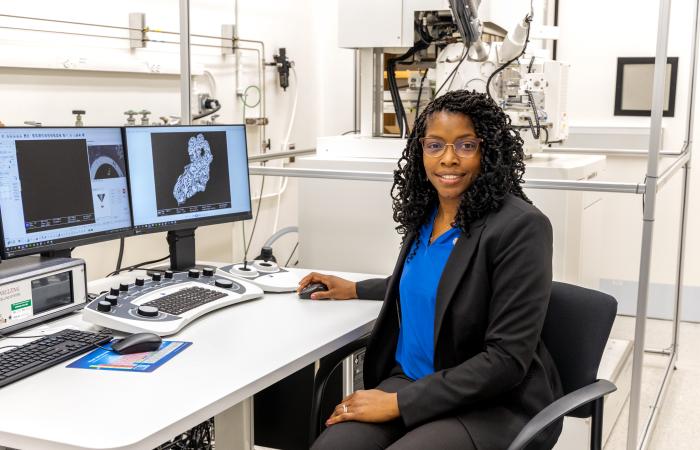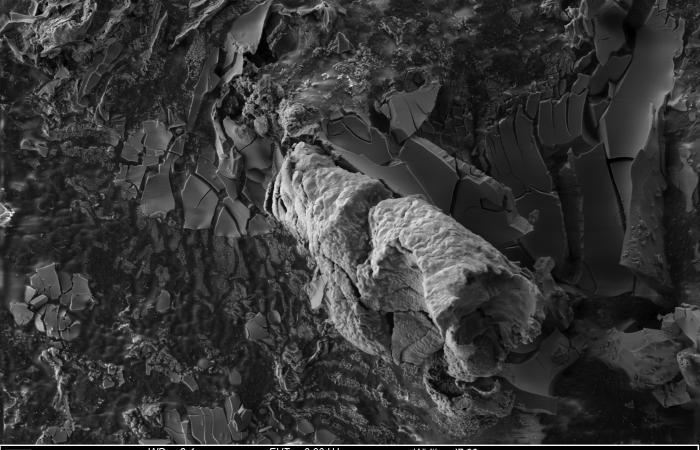After completing a bachelor’s degree in biology, Toya Beiswenger didn’t intend to go into forensics. But almost two decades later, the nuclear security scientist at the Department of Energy’s Oak Ridge National Laboratory has found a way to appreciate the art of nuclear forensics. Using scanning electron microscopy, she characterizes radioactive and non-radioactive material in real world samples; at the same time, she is a voracious consumer of the subtle and not-so-subtle information that emerges from each sample.
Nuclear forensics aims to robustly connect results of high precision laboratory techniques to the origin and history of a sample. Results from these examinations are used in several contexts, including the assessment of nuclear security vulnerabilities, treaty verification and law enforcement actions. Beiswenger works directly on developing new analytical techniques to potentially maximize the information available for assessments using the state-of-the-art instrumentation available at ORNL.
“There is a component of looking for a needle in a haystack in the field of nuclear forensics,” Beiswenger said. “I’m interested in what stands out in each sample that's different from what I've seen in other samples.”
Beiswenger’s instrument of choice is a scanning electron microscope, or SEM. An SEM uses electrons and x-rays to help researchers understand the characteristics of a sample. Electrons provide topographical and compositional information, and characteristic x-rays from the sample help identify elements in the sample. These signals give scientists like Beiswenger an up-close and personal view of the material.
Beiswenger likens working with a sample to building a relationship. “First, I see how the sample interacts with the beam. Then I look at whether it’s robust enough to handle various currents to optimize signal-to-noise. I find the sharpest focus and tweak the alignment, then it pops! That gotcha moment when the sample scans as it comes into perfect focus is very exciting and satisfying,” she said. The SEM analytical technique is the gateway to determine what additional methods might provide more information to the researcher.
“We may not be able to see the subtle differences with our eyes, but putting a sample into an SEM with mapping capability broadens the view into a microscopic world,” said Beiswenger. Whether a sample looks like a plate, a sphere, a porous rock or a jagged crystal can direct scientists on how to acquire other data to improve overall understanding of what the material is trying to convey.
Beiswenger has always been interested in science. Her first exposure to forensics came while working for a sheriff’s department crime lab, where she learned how to use an SEM to identify tiny clues in gunshot residue. The call to try something new led Beiswenger to apply to a job opening in forensics at Pacific Northwest National Laboratory; the work spoke to her. She appreciated learning how her data could be used to help analysts understand the samples and how the information gained from the samples could be used in decision making and assessments.
Along with her increasing experience with SEM, she decided to pursue higher education, completing her doctorate program in environmental and natural resource sciences in 2020 from Washington State University Tri-Cities. Her dissertation focused on identifying spectroscopic signatures of uranium bearing minerals mixed among various background material and how particle size plays a role in interpreting these signatures.
What Beiswenger learned during her 12 years at PNNL poised her to take on a critical role when she joined the Analytical Development and Operations group in the Nuclear Nonproliferation Division at ORNL in November 2021. ADO develops materials analysis workflows coupling disparate analytical techniques to provide as much information as possible about samples. A key component of the work is translating new material discoveries made at ORNL to actionable characterization techniques and methods. One significant instrumentation asset under the purview of ADO and a growing capability in SEM workflows is automated analysis, which allows users to rapidly screen samples for characteristics of interest.
These capabilities produce huge volumes of image and characterization data, perfect machine learning fodder for computational resources and algorithm development. Beiswenger, through her understanding of automated analysis, seeks to grow the automated capability and further develop efficient analytical workflows across multiple projects. She is already expanding her impact, working as a co-primary investigator on a new Laboratory Directed Research and Development project, where she looks to use mapping capabilities to rapidly identify particles of most interest in a high background matrix.
Despite the potential national security impact, the little things are what Beiswenger enjoys about her job. What she sees when she views samples in the SEM is nature’s art on display. Difficult samples require precision and patience to find the right parameters that reveal features otherwise hidden.
“There’s beauty in a backscatter electron image or seeing the texture of a sample in a secondary electron image,” Beiswenger said. “It’s something that keeps me coming back to work day after day.”
UT-Battelle manages ORNL for the Department of Energy’s Office of Science, the single largest supporter of basic research in the physical sciences in the United States. The Office of Science is working to address some of the most pressing challenges of our time. For more information, please visit energy.gov/science. — Liz Neunsinger




